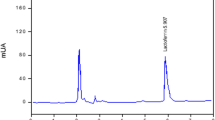Abstract
Bovine milk proteins bind calcium and some bind other metal ions or heme. The examination of heme-binding proteins in colostrum and milk using hemin-agarose beads (HA) showed α-casein, κ-casein and lactoferrin (Lf) to be heme-binding proteins. α-Casein and Lf are iron- and heme-binding proteins, and α- and κ-casein bind to HA, as does Lf. κ-Casein and Lf have higher affinity to zinc ion than does α-casein, and κ-casein and Lf interact with α-casein-immobilized beads (CasB). The addition of α-casein to κ-casein bound to CasB decreased the amount of bound κ-casein compared with in the absence of α-casein, and κ-casein likely increases α-casein self-association. α-Casein binds Lf bound to neither iron nor heme, as shown by experiments with the apo-form. Beads with immobilized poly-l-lysine bind heme but Lf inhibits this binding. These results indicate that α-casein, κ-casein and Lf are both heme- and zinc-binding proteins, and that α-casein interacts with κ-casein and Lf through protein-protein interactions. Additionally, Lf shows higher affinity to hemin than does poly-l-lysine.



Similar content being viewed by others
References
Adlerova L, Bartoskova A, Faldyna M (2008) Lactoferrin: a review. Vet Med 9:457–468
Babic M, Horák D, Trchová M, Jendelová P, Glogarová K, Lesný P et al (2008) Poly(L-lysine)-modified iron oxide nanoparticles for stem cell labeling. Bioconj Chem 19:740–750. https://doi.org/10.1021/bc700410z
Farrell HM Jr, Jimenez-Flores R, Bleck GT, Brown EM, Butter JE, Creamer LK et al (2004) Nomenclature of the proteins of cows’ milk-sixth revision. J Dairy Sci 87:1641–1674. https://doi.org/10.3168/jds.S0022-0302(04)73319-6
Ise N, Okubo T, Sekiguchi T, Mita K (1974) Carbamoylated poly-L-lysine and its helix-coil transition. Bull Inst Chem Res 52:416–424
McGraph BA, Fox PF, McSweeney PL, Kelly AL (2016) Composition and properties of bovine colostrum: a review. Dairy Sci Technol 96:133–158. https://doi.org/10.1007/s13594-015-0258-x
Naito K, Iio T, Katagi M, Yoshikawa Y, Ohtsuka H, Orino K (2020) Binding analysis of bovine milk proteins, especially casein interactions and the interaction between α-casein and lactoferrin, using beads immobilized with zinc ion, poly-L-lysine or α-casein. Int Dairy J 105:104690. https://doi.org/10.1016/j.idairyj.2020.104690
Orino K (2016) Physiological implications of mammal ferritin-binding protein interacting with circulating ferritin and a new aspect of ferritin- and zinc-binding proteins. Biometals 29:15–24. https://doi.org/10.1007/s10534-015-9897-x
Pomastowski P, Sprynskyy M, Buszewski B (2014) The study of zinc ions binding to casein. Colloid Sur B Biointerfaces 120:21–27. https://doi.org/10.1016/j.colsurfb.2014.03.009
Prasad AS (2009) Zinc: role in immunity, oxidative stress and chronic inflammation. Cur Opin Clin Nutr Metab Care 12:646–652. https://doi.org/10.1097/MCO.0b013e3283312956
Saito N, Iio T, Yoshikawa Y, Ohtsuka H, Orino K (2018) Heme-binding of bovine lactoferrin: the potential presence of a heme-binding capacity in ancestral transferrin gene. Biometals 31:131–138. https://doi.org/10.1007/s10534-017-0075-1
Shibuya N, Yoshikawa Y, Watanabe K, Ohtsuka H, Orino K (2012) Iron-dependent binding of bovine milk α-casein with holo-lactoferrin, but not holo-transferrin. Biometals 25:1083–1088. https://doi.org/10.1007/s10534-012-9573-3
Silaniscove N, Shapiro F, Shamay A (2003) Use of an ion-selective electrode to determine free Ca ion concentration in the milk of various mammals. J Dairy Res 70:241–243. https://doi.org/10.1017/s0022029903006083
Stryer L (1961) A conformation-dependent cotton effect in the Soret band of hemin. Biochim Biophys Acta 54:395–357
Sugawara G, Inoue R, Watanabe K, Ohtsuka H, Orino K (2009) Bovine α-casein is a ferritin-binding protein and inhibitory factor of milk ferritin immunoassay. J Dairy Sci 92:3810–3814. https://doi.org/10.3168/jds.2008-1948
Szyk-Warzyńska L, Piekoszewska J, Warszyński P (2010) Formation and stability of poly-L-lysine/casein multilayers. Adsorption 15:241–248. https://doi.org/10.1007/s10450-0101-9227-0
Usami A, Tanaka M, Yoshikawa Y et al (2011) Heme-mediated binding of α-casein to ferritin: evidence for preferential α-casein binding to ferrous iron. Biometals 24:1217–1224. https://doi.org/10.1007/s10534-011-9470-1
Wang H, Hurley WL (1998) Identification of lactoferrin complexes in bovine mammary secretions during mammary gland involution. J Dairy Sci 81:1896–1903. https://doi.org/10.3168/jds.S0022-0302(98)75761-3
Author information
Authors and Affiliations
Corresponding author
Ethics declarations
Conflict of interest
The author declares no conflicts of interest.
Additional information
Publisher's Note
Springer Nature remains neutral with regard to jurisdictional claims in published maps and institutional affiliations.
Electronic supplementary material
Below is the link to the electronic supplementary material.
10534_2020_252_MOESM1_ESM.docx
Fig. S1 The binding of α-casein to HA α-Casein (50 µg) was purchased from Sigma (St. Louis, MO, USA), dissolved in 1 mL of PBS containing HA or agarose beads as control beads (net volume of beads per sample: 25 µL), and the mixture was rotated at 4°C overnight. The mixture was centrifuged at 16,000 x g for 5 min at 4°C, then the pelleted beads were washed three times with 1 mL of PBS as described in Figure 1. The supernatant (S) was collected after the first centrifugation before washing each beads (B) by suspension in PBS. The proteins were released from each beads (B) and denatured by SDS, then subjected to SDS-PAGE together with S. α-Casein was separately applied to the gel (2 µg/lane). M represents marker proteins. The arrow indicates the migration of α-casein. (DOCX 756 kb)
Rights and permissions
About this article
Cite this article
Orino, K. Heme-binding ability of bovine milk proteins. Biometals 33, 287–291 (2020). https://doi.org/10.1007/s10534-020-00252-2
Received:
Accepted:
Published:
Issue Date:
DOI: https://doi.org/10.1007/s10534-020-00252-2




